|
previous topic :: next topic |
| Author |
Message |
dangler

Since 26 Feb 2006
1781 Posts
WINDY SPOTS
XTreme Poster
|
 Tue May 28, 13 1:50 pm kite power Tue May 28, 13 1:50 pm kite power |
 |
|
Hell, Bill Hansen figures this shit out in his head just to pass the time!
_________________
Kite Repair? AND WINGS Call me.(509) six 37-four five 29 |
|
|
JonMalmberg
Since 15 Aug 2011
340 Posts
Obsessed
|
 Tue May 28, 13 2:01 pm Tue May 28, 13 2:01 pm |
 |
|
You guys are funny.
Do you really think all these variables are involved in current kite design. Hate to shatter your perception, but kite designers are working on designing kites that work in the real world and items like power, de-power, and turning speed are a characteristics that are qualified by subjective real world testing and are not quantified in any objective way.
There is not nearly the volume or profit margin to support the level of detailed design work you guys are talking about. Go enjoy your kite and if you don't like it, demo others. Everyone has their own subjective view on both what they view as an important design aspect and how they measure it based on the variables of where and how they kite board. As Spinal Tap says, mine goes to 11.
If you think I am blowing smoke, check my background. I ain't telling porky pies. Although I do current work in an industry that is the complete opposite. Have fun theorizing and maybe even getting some measurements of your own, but in the end the kiting industry and/or the average consumer does not care one little bit.
Jon Malmberg
|
|
|
Weaz

Since 23 May 2012
360 Posts
Beaverton
Obsessed
|
 Tue May 28, 13 3:13 pm Re: kite power Tue May 28, 13 3:13 pm Re: kite power |
 |
|
| dangler wrote: | | Hell, Bill Hansen figures this shit out in his head just to pass the time! |
And he does a damn good job of it too. *insert my kite pimp*
_________________
Switch Nitro II (8m, 10m, 12m)
2011 Slingshot Key (10m, 13m) |
|
|
registered

Since 12 Jul 2005
1319 Posts
tsunami
Sandbagger
|
 Tue May 28, 13 5:36 pm Tue May 28, 13 5:36 pm |
 |
|
designed by a group of chinese seamstresses on a sewing table after the other group chopped up the materials laying around .
Same with the bar and bridles........ get it roughed out .... leave the details to the professionals (manufacturers seamstress).. 
dorks......we need wind at my coast
|
|
|
bwd

Since 04 Aug 2007
385 Posts
Obsessed
|
 Tue May 28, 13 7:26 pm Tue May 28, 13 7:26 pm |
 |
|
you can also use lots of data to pick stocks.
Let me know when you get rich. 
otherwise, as my first and only kite instructor told me,
 FEEL THE POWER!!! FEEL THE POWER!!!
|
|
|
PistolPete

Since 26 Apr 2010
18 Posts
Â
|
 Tue May 28, 13 7:53 pm Tue May 28, 13 7:53 pm |
 |
|
The two attached graphs (sheeted-out & sheeted-in) illustrating the pulling force of a kite in varying airspeeds. This is based on simple calculations using the lift coefficient equation and is intended to show a few conceptual relationships only. Estimations/ Inaccuracies include:
- Kite is not an ideal foil-bearing body
- Kite planform area is not uniform
- Kite chord varies and is flexible
- Inefficiencies unaccounted for
- Lift Coefficient values vary
- Air Density values vary
- And many more
The illustrations have a color overlay indicating a notional limited usable range. There are calculated curves for 5, 10, and 15 square meter planform/projected area kites. This is different than the typical windrange-vs-kite size correlations. Hopefully this helps to visualize the magnitude of force at various airspeeds, using different size kites. What is not included is the direction of the force (vector), which helps determine how useable the force will be.
Airspeed is calculated as a function of force in the illustrations. Beach windspeed (true wind velocity) is easy to visualize with a steady kite as it is equal to the kite airspeed (apparent wind velocity). As soon as the kite moves, the apparent wind velocity changes. The kite can be moved by steering (sine-ing) and/or being set in motion from sailing. Y-axis airspeed can be visualized using three different perspectives:
(1) As beach/true wind velocity (for forces seen static flying)
(2) As kite/apparent wind velocity (for total forces seen at the kite)
(3) As sailing and/or sin-ing wind velocities (for forces the rider controls)
One of the graphs illustrates the minimum calculated forces for a kite sheeted-out (using CL=0.75) and the other graph illustrates the maximum calculated forces for a kite sheeted-in (using CL=1.7). The two graphs show different usable kite windranges depending on the sheeting of the kite. Again the specific graph numbers may not be accurate to actual kite performance but, this does provide a general idea of the range a depower kite could provide. Many other pro/con variables influence actual airspeed-vs-force curves. Kite shape, rigidity, weight, line lengths, etc
are ignored for mathematical simplicity. The above concepts are all well known, but sometime drawing a picture helps.
Ref:
http://en.wikipedia.org/wiki/Lift_coefficient
http://en.wikipedia.org/wiki/Air_density
http://en.wikipedia.org/wiki/Planform
http://en.wikipedia.org/wiki/Wind_triangle
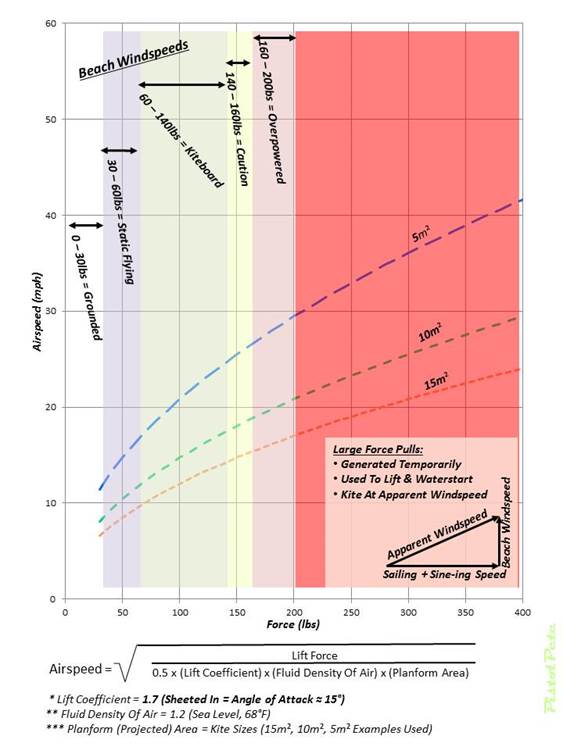 |
| |
SheetIn.jpg |
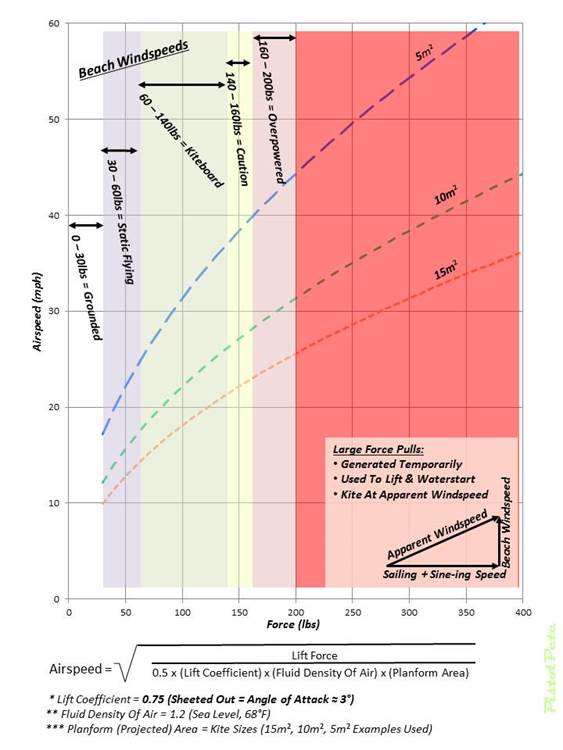 |
| |
SheetOut.jpg |
Last edited by PistolPete on Thu May 30, 13 8:48 pm; edited 2 times in total |
|
|
Windstoked
Since 21 May 2013
43 Posts
Norcal
Â
|
 Wed May 29, 13 7:46 am Wed May 29, 13 7:46 am |
 |
|
Wow! Thanks to all for some very interesting and helpful insights into kite technology. I hadn't realized the complexity of it.
My interest started after a light wind session where my kiting partners and I discovered we could kite with a Slingshot 12 RPM and RRD 12 Obsession but couldn't stay upwind with a Naish 14 Park. We're all around 200lbs and experienced riders, and switched kites to make sure it wasn't a different variable. I started wondering if there's this much variability in usable power among kites in general.
I had a 10m Park I liked and figured the 14 would be good for lighter wind, but it was just wasted money. The 14 Park may still be good for higher winds with a heavier kiter.
|
|
|
Weaz

Since 23 May 2012
360 Posts
Beaverton
Obsessed
|
 Wed May 29, 13 8:35 am Wed May 29, 13 8:35 am |
 |
|
A lot of times the difference in low end wind range between a 12m and 14m are only 1-2 knots. That combined with a slower moving kite the apparent wind generation can take less of an effect. What you need to look for in a light wind kite is having a large apparent surface area (drag) and that the kite can move fairly fast. That being said if you look at most light wind kites they are more bow or delta shaped than traditional C shaped.
Also I've personally struggled on a 13m kite when one person hopped on his 9m and took off like a bat out of hell... yes he was working his kite hard and looping it till he was moving fast and was down looping every transition..
Honestly light wind kiteing is different than when you are on a 6-12m kite. Once you get above the 12m USUALLY the kite responds a lot slower, power generation feels different, everything seems delayed about a 1/2 second. You have to be a lot more forceful with the kite to get going.
_________________
Switch Nitro II (8m, 10m, 12m)
2011 Slingshot Key (10m, 13m) |
|
|
JeffT
Since 07 Jul 2012
238 Posts
Deep Southern Portland
Stoked
|
 Wed May 29, 13 1:24 pm Wed May 29, 13 1:24 pm |
 |
|
@JonMalmberg
I want your job!!!
  
_________________
Jeff |
|
|
PistolPete

Since 26 Apr 2010
18 Posts
Â
|
 Thu May 30, 13 8:16 pm Thu May 30, 13 8:16 pm |
 |
|
Temperature
Attached is a temperature plot for the 10m planform area wing. The blue (lower=less wind needed for pull) lines are for air density for very cold dry air (23°F or -5°C = 1.13Kg/m³ @ Sea Level) and the red (upper=more wind needed for pull) line represents very hot dry air (105°F or 40.5°C = 1.32Kg/m³ @ Sea Level). The biggest difference is on the Sheeted-Out plot because lift efficiency is low so, more wind is needed to make up the difference in air density. Some numbers are:
50lbs of pull sheeted-out needs 1.7mph more wind for hot air (sheeted-in needs 0.8mph).
100lbs of pull sheeted-out needs 2.4mph more wind for hot air (sheeted-in needs 1.1mph).
150lbs of pull sheeted-out needs 2.9mph more wind for hot air (sheeted-in needs 1.4mph).
200lbs of pull sheeted-out needs 3.4mph more wind for hot air (sheeted-in needs 1.6mph).
250lbs of pull sheeted-out needs 3.8mph more wind for hot air (sheeted-in needs 1.8mph).
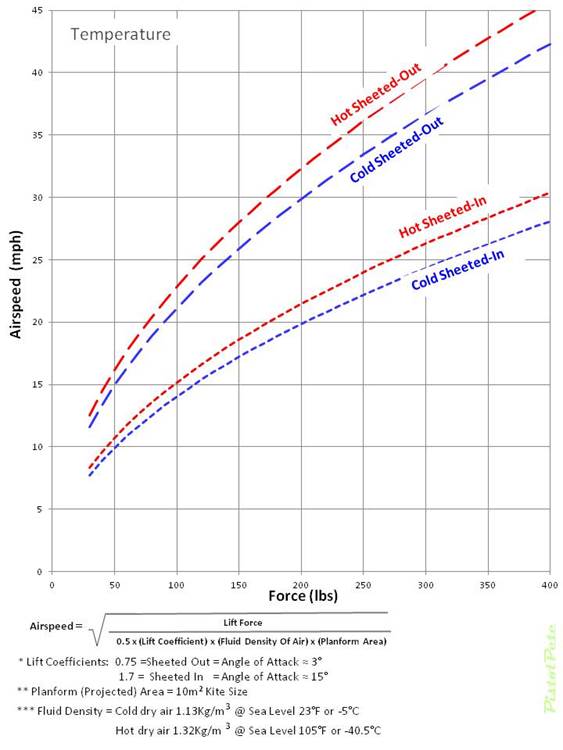 |
| |
Temperature.jpg |
|
|
|
PistolPete

Since 26 Apr 2010
18 Posts
Â
|
 Thu May 30, 13 8:17 pm Thu May 30, 13 8:17 pm |
 |
|
Altitude
Attached is an altitude plot for the 10m planform area wing. The green (lower) lines are for air density for sea level dry air (1.2Kg/m³ @68°F/20°C) and the purple (upper) line represents dry mountain air at 10,000ft/3048m (0.826Kg/m³ @ 68°F/20°C). To show only the altitude differences, the temperatures are held same but, note that would be a warm day that far up a mountain. Some numbers are:
50lbs of pull sheeted-out needs 2.6mph more wind for mountain air (sheeted-in needs 2.1mph).
100lbs of pull sheeted-out needs 3.7mph more wind for mountain air (sheeted-in needs 3.0mph).
150lbs of pull sheeted-out needs 4.5mph more wind for mountain air (sheeted-in needs 3.7mph).
200lbs of pull sheeted-out needs 5.2mph more wind for mountain air (sheeted-in needs 4.2mph).
250lbs of pull sheeted-out needs 5.9mph more wind for mountain air (sheeted-in needs 4.8mph).
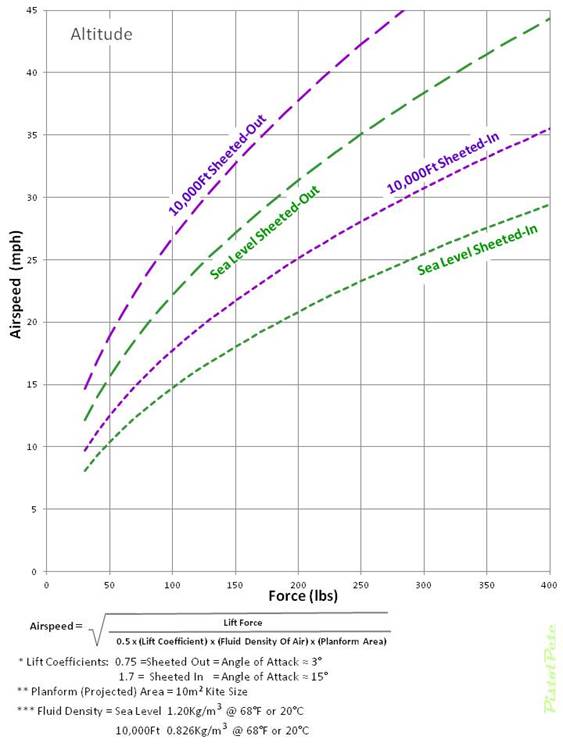 |
| |
Altitude.jpg |
|
|
|
PistolPete

Since 26 Apr 2010
18 Posts
Â
|
 Thu May 30, 13 8:18 pm Thu May 30, 13 8:18 pm |
 |
|
Humidity
No plots needed for this one  Even for worst case (high temperature) Air Density only varies 0.3% between the full range of 0% and 100% humidity. Dryer air is denser (better for lift) than humid air, because water has less molecular mass than air. If it is raining, your kite will get heavier, and you will lose pull, otherwise humidity is really a non-factor. Even for worst case (high temperature) Air Density only varies 0.3% between the full range of 0% and 100% humidity. Dryer air is denser (better for lift) than humid air, because water has less molecular mass than air. If it is raining, your kite will get heavier, and you will lose pull, otherwise humidity is really a non-factor.
|
|
|
PistolPete

Since 26 Apr 2010
18 Posts
Â
|
 Thu May 30, 13 8:18 pm Thu May 30, 13 8:18 pm |
 |
|
Wind Gusts
Attached is a plot for gusts-vs-pull assuming 68°F/20°C dry sea level air at 60lbs of steady lift (17mph wind sheeted-out or 11.5mph sheeted-in). For simplicity it is assumed the wind gusts are in the same direction as the apparent wind seen by the kite (worst case). Actual gusts are generally in the true wind direction. The brown (upper) line represents when sheeted-out what gust speeds cause what additional pull. The pink (lower) line represents when sheeted-in what gust speeds cause what additional pull. This plot shows why it can be much more challenging to kite in gusty conditions. And, the lulls that accompany gusts add even more to the challenge (by reducing pull). This plot also illustrates that the effects of gusts/lulls are quite a bit more pronounced when sheeted-in. Some numbers are:
Sheeted-In
4mph gusts while sheeted-in sailing in 17mph winds adds 50lbs of pull
7mph gusts while sheeted-in sailing in 17mph winds adds 100lbs of pull
10mph gusts while sheeted-in sailing in 17mph winds adds 150lbs of pull
12mph gusts while sheeted-in sailing in 17mph winds adds 200lbs of pull
Sheeted-Out
6mph gusts while sheeted-in sailing in 17mph winds adds 50lbs of pull
11mph gusts while sheeted-in sailing in 17mph winds adds 100lbs of pull
15mph gusts while sheeted-in sailing in 17mph winds adds 150lbs of pull
19mph gusts while sheeted-in sailing in 17mph winds adds 200lbs of pull
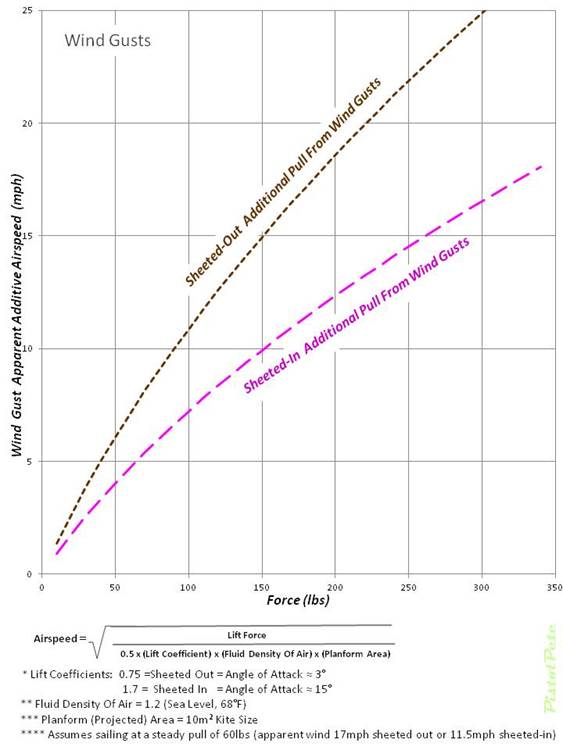 |
| |
Gusts.jpg |
|
|
|
Justsmile

Since 20 Jul 2009
1530 Posts
Not Portland
XTreme Poster
|
 Thu May 30, 13 9:10 pm Thu May 30, 13 9:10 pm |
 |
|
wow, those graphs are f......ng awesome!!!! now can I get an interpreter that speaks my language!!
|
|
|
Weaz

Since 23 May 2012
360 Posts
Beaverton
Obsessed
|
 Thu May 30, 13 9:56 pm Thu May 30, 13 9:56 pm |
 |
|
More wind more power. Dense air = more power. Colder air = more power. Lower altitude = more power.
_________________
Switch Nitro II (8m, 10m, 12m)
2011 Slingshot Key (10m, 13m) |
|
|
sfbomber

Since 27 Jun 2012
114 Posts
Stoked
|
 Fri May 31, 13 7:07 am Fri May 31, 13 7:07 am |
 |
|
| I remember reading an article several years back that came out of Germany that compared 4 different kite designs, ala Mythbusters style. They had a pickup truck, with a rigging contraption, equipped with spring loaded force meters. Set the truck at cruise control then fly the kite and video the tension on the weight meter. I think they were just interested with the pull on the chicken loop. You could attach ropes to the bar ends, that are connected to force meters, and be able to measure the bar pressure.
|
|
|
DownStream
Since 18 Apr 2007
381 Posts
Obsessed
|
 Thu Jun 06, 13 11:28 am Thu Jun 06, 13 11:28 am |
 |
|
wth?? how did this happen on the forum???? cant help but be interested, but feels weird. who are you graph-guy, and have you actually confirmed or attempted to confirm any of this in real life measurements?
_________________
PROKITE LESSON CENTER
SOUTH PADRE ISLAND
541 490 6872
www.ProKiteLessons.com
info@prokitesouthpadre.com |
|
|
|







